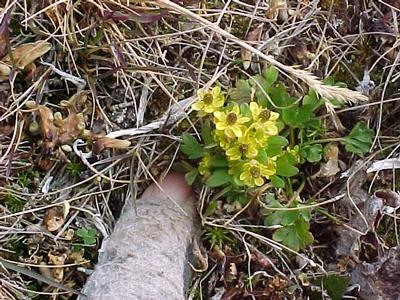8 July, 2001
Sunday
Another day of cold, gray skies along with flurries all day. This is
summer in Barrow! I'd rather it snow than rain if I have to be out
working so all was fine with me!
Sunday starts out with brunch at 11:30. Most everybody gets to sleep in
and it is well deserved and anticipated! Last night we had our movie
night and watched "Quills". Joe's DVD player turns the Racquetball Court
into a multiplex (almost) cinema minus the cup holders and the reclining
seats.
I found some papers Michelle had completed the first week she was here.
What she did was color code data collected in 1998 that recorded the
plants and the microclimate present at each of the 10meter and 20 meter
flag points of the tower transects. I thought it might be interesting to
update the information now, 3 years later, to see if any changes in either
area occurred. Things do now change very quickly here and this would be a
way of finding out what has and hasn't changed and to see if there are
any trends occurring. So, for my final 2 weeks project, I will be doing
that along with helping Glen at his site. Identifying species at Glen's
site the past weeks helps now with identifying the species present at the
transect points (and I never thought I'd used my new found knowledge of
Arctic plant species again!).
Glen went out with Lety and I today to get us started. Lety was once
again taking LiCor measurements at all her sites. Glen was at his site
watering the tundra! He has plots, which need to be at a higher water
level than the control plots so he literally has to haul water out there
to keep the levels high!
I started walking the tower transects making observations of the plants
and microclimate every 10 meters for 20 flags and then every 20 meters for
10 flags. Like anything at first glance a project looks simple and
straightforward. When you actually start doing the task all the little,
hidden complexities appear and things aren't as simple as they originally
appeared! After finding the correct transect, there are 7, and comparing
my observations to the originals I figured I needed some tutorials on
microclimates. Glen is going out with me tomorrow to go over the
difference between a flat centered, high-centered and low-centered
ice-wedge polygons for starters. What's a polygon you ask? There was an
arial shot I took from the plane a few weeks ago showing tundra polygons.
They are the distinct, many-sided shapes the tundra takes due to the
freeze-thaw cycles that the soil undergoes here.
Walking the transects I had time and opportunity to take flower pictures
and also found some other treasures along the way.
An interesting note here about the lemming population. Among all of us in
the field we haven't seen more than 5 lemmings total this season.
Lemmings are small rodents that look like fat, furry, mice without the
long tail. They are a favorite food of snowy owls and some years they are
present in large numbers. This is a bad year for lemmings and hence a
year for few to no sightings of snowy owls. The local paper reported that
no new nests had been found and the two owls, which have been tracked for
the past years, came and left Barrow without nesting. Another example of
prey populations controlling predator populations.

Owl pellets found from an old nesting site. Their main diet consists of lemmings here so I'm certain that's what each pellet contains.

You've seen the regular buttercup. These are the dwarft buttercups, Ranunculus pygmacus. My gloved finger is there for scale.

Papaver Macounii, arctic poppy, is just starting to be scene. They like everything up here are small and low to the ground.

A Petasities frigida forest with CMDL in the background. Actually these are no taller than 2 to 3 inches high and tower over all the other plants here with the exception of various grasses!
Contact the TEA in the field at
.
If you cannot connect through your browser, copy the
TEA's e-mail address in the "To:" line of
your favorite e-mail package.
|
